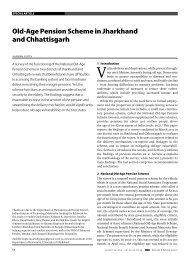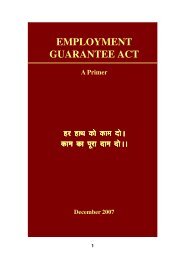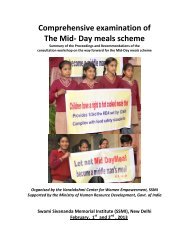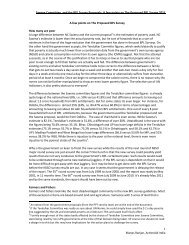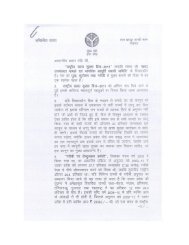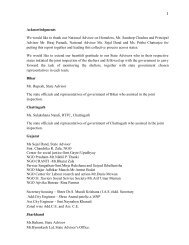NREGA: Opportunities and Challenges - Diksha
NREGA: Opportunities and Challenges - Diksha
NREGA: Opportunities and Challenges - Diksha
Create successful ePaper yourself
Turn your PDF publications into a flip-book with our unique Google optimized e-Paper software.
<strong>NREGA</strong>: OPPORTUNITIES AND CHALLENGESSIDHI’S WELL BEINGSThe grin in Nepal Singh’s face, a 50-year-old farmer in Siddhi district’s Barmani village, is unusual. This is the fourthconsecutive drought the dominantly agrarian district is facing. Singh doesn’t remember a drought year in past when he didn’tmigrate. Usually a drought means miseries: no earning, distress migration to hostile urban areas <strong>and</strong> a step into the viciousdebt trap. “This year I have earned more money from agriculture than ever. For the first time in many decades I had mywinter crop this year besides the bumper monsoon crop,” he says tending his lush kitchen garden. “The vegetable gardenhas also ensured my year long supply of vegetables saving me a lot of money.”During January-February 2007 Singh got his ab<strong>and</strong>oned dug well renovated under the <strong>NREGA</strong>. Twenty-five people fromthe village including Singh’s own family members worked on it for three months earning Rs. 2000 each. “It happened at atime when we usually migrate out for survival. The works stopped us from doing that while creating water source for myirrigation,” says Singh. “The wage was less but I got the benefit of assured water in my well.”Despite the bad monsoon of 2007-08, the well water has been sufficient to assure irrigation for Singh’s five acres of l<strong>and</strong>.Earlier he could barely manage to cultivate two acres from the erratic monsoon. This year he took up cultivation in five acresbesides using the water for vegetable in the kitchen garden. His earning from agriculture doubled from Rs. 4500 a year to Rs.10,000 this year. Due to the assured water source his winter crop has added Rs. 10,000 more to his earning: he now cultivateswheat, an unheard of proposition in the parched district. And he estimates that the kitchen garden saved him around Rs.1000 as he stopped buying vegetables from markets.Siddhi has invested heavily on digging <strong>and</strong> renovating wells under the <strong>NREGA</strong>. The district has 8000 wells beingundertaken in the last two years while 4000 have already been completed <strong>and</strong> used. Out of the district’s last year expenditureof Rs 65 crore in <strong>NREGA</strong>, Rs. 35 crore was spent on water conservation, mostly in digging <strong>and</strong> renovating wells. “The district’sgroundwater level is very good. The soil is without rocks thus digging wells are easier. Given the 60:40 ratio of wage <strong>and</strong>materials under the <strong>NREGA</strong>, wells come as a suitable productive assets,” reasons Nisar Ahmed, the chief of district Panchayat.Siddhi’s dominant population of scheduled castes <strong>and</strong> tribes is another reason for such a large number of private assets beingtaken up under the <strong>NREGA</strong>. The Act allows development <strong>and</strong> creation of assets in private l<strong>and</strong>s of SC/STs.However the district has a problem of plenty. The district has created around 6,000 water harvesting structures in thelast seven years under the state’s Rajiv G<strong>and</strong>hi Wateershed Development Mission. Many villages have experienced increase ingroundwater level <strong>and</strong> agricultural productivity has increased.The <strong>NREGA</strong> came as another opportunity to perpetuate the water conservation works undertaken by the watersheddevelopment mission. “Watershed development has raised groundwater level. The wells under <strong>NREGA</strong> have been able toexploit the raised groundwater situation,” says Kedar Rajak of Gram Sudhar Samiti, a NGO based in Sidhi.But the issue of maintanance of such a large number of water harvesting structures haunts the sustainability of thedistrict’s experiment with water conservation. Watershed structures have a life span of 15-20 years. The wells <strong>and</strong> check damsbuild under the <strong>NREGA</strong> need regular maintenance. But there is hardly any money left with Panchayats to do that. <strong>NREGA</strong>would have been helpful in doing maintenance works in watershed structures. “<strong>NREGA</strong> should have allowed us to maintainearlier structures instead of creating new ones,” says Rajendra Singh, a farmer from the district’s Khar village.Till June 2007, 149 tanks had been completed with an expenditure of Rs 1.19 crore <strong>and</strong> 639 tanks areunder construction. Similarly, 10 minor irrigation canals have been completed in the district <strong>and</strong> another25 are under construction. “Due to this, water availability has gone up dramatically resulting in farmerstaking up cultivation of rice, wheat <strong>and</strong> vegetables,” says Ragen Singh, a farmer, who has one Ha of l<strong>and</strong>.“There have been no cases of migration from Bhaghohar Gram Panchayat this year as water availability ishigh,” says Jagat Niwas P<strong>and</strong>ey, director, Gurukul Shikshan Sansthan, an NGO based in Sidhi.Sidhi also has been a good example of water <strong>and</strong> soil conservation under the state’s Rajiv G<strong>and</strong>hi WatershedDevelopment Mission. The programme has covered the entire natural drainage system. The district now facesa problem of plenty: many villages don’t want new water harvesting structures being built under <strong>NREGA</strong>. Rather,they want <strong>NREGA</strong> money to be spent on maintaining the existing structures (see Box: Sidhi’s well being).According to an official of the Madhya Pradesh government involved in the watershed project, usuallywatershed structures have a life span of 15-20 years. If maintenance of these structures is not taken upon a priority basis, villages turn from water-rich to water-deficient regions. Under <strong>NREGA</strong>, construction of atank has been taken up in Khaira village at an estimated cost of Rs 7 lakh. “Khaira village has alreadyseveral water conservation structures; <strong>NREGA</strong> allocations could have been used for maintenance ofstructures built under the watershed mission,” says Rajendra Singh, a farmer of the village.45



